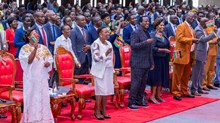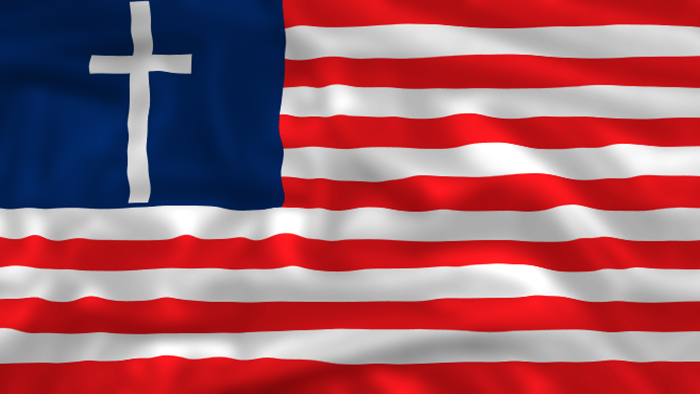
The main methods for measuring American faith are flawed.
So thinks the Pew Research Center, which today released the second wave of a massive study designed to “fill the gap” left by the United States census (no questions on religion), the self-reporting of denominations (“widely differing criteria”), and smaller surveys (too few questions or people).
Scrutinizing the past seven years, Pew finds that, amid the rise of the “nones” and other popular talking points, the fate of evangelicals is proving much brighter than Christianity at large.
Here are highlights from the US Religious Landscape Study, conducted among more than 35,000 adults in English and Spanish, of how American religion has changed from 2007 to 2014:
1) Evangelicals have remained remarkably stable
Over the past seven years, evangelicals have lost less than 1 percent of their share of the population, holding steady at about 1 in 4 American adults (25.4% in 2014, vs. 26.3% in 2007) and preserving their status as the nation’s largest religious group.
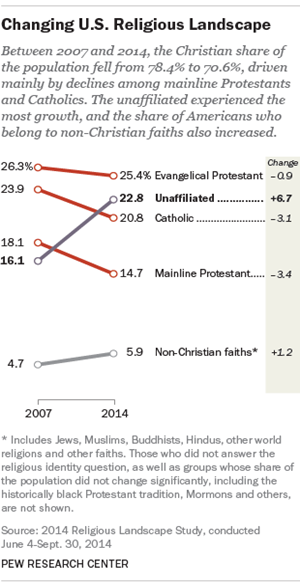
In contrast, mainline Protestants have lost almost 3.5 percent of their population share and are currently less than 15 percent of American adults, while Catholics lost about 3 percent of their population share and are currently about 21 percent of adults.
The declines have allowed the religiously unaffiliated, who gained nearly 7 percent in population share, to surge past Catholics and mainline Protestants to become America’s second-largest religious group (22.8% of adults). (Historically black Protestant denominations, tracked separately though nearly three-quarters of their members identify as evangelicals, were statistically unchanged.)
Evangelical churches also added more than 2 million people to their ranks, up from 59.8 million in 2007 to 62.2 million in 2014. Meanwhile, mainline churches lost 5 million people. “As a result, evangelicals now constitute a clear majority (55%) of all US Protestants,” noted Pew.
The population share of evangelicals rises even higher when identified differently.
For the above findings, Pew categorized Americans by denominational affiliation. (Evangelical denominations include the Southern Baptist Convention, the Assemblies of God, Churches of Christ, the Lutheran Church-Missouri Synod, the Presbyterian Church in America, and nondenominational churches.) But Pew also asked: “Would you describe yourself as a born-again or evangelical Christian, or not?”
In response, about one-third of American adults (35%) self-identified as evangelicals in 2014, nearly the same as in 2007 (34%). Meanwhile, Americans who self-identified as Christians dropped from 78 percent in 2007 to 71 percent in 2014.
2) The label “evangelical” is more popular among all Christian groups
Today, all Christians are more likely to consider themselves “born-again” or evangelical. Half of self-identified Christians described themselves this way in 2014, up from 44 percent in 2007. This includes 72 percent of those in historically black Protestant churches, up from 67 percent in 2007.
More surprisingly, a rising share of adults in other Christian traditions self-identify as born-again or evangelical, including: mainline Protestants (27% in 2014 vs. 25% in 2007), Catholics (22% vs. 16%), Orthodox (18% vs. 16%), Mormons (23% vs. 21%), Jehovah’s Witnesses (24% vs. 17%), and spiritualist Christians (24% vs. 15%).
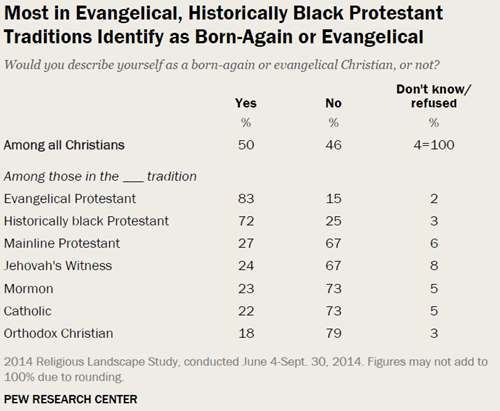
By contrast, 15 percent of adults in evangelical churches do not identify as born-again or evangelical. Neither do 21 percent of those at nondenominational churches, or 10 percent of those at Pentecostal churches.
Some Protestant denominational families are quite divided on this measure, including Methodists (45% born-again or evangelical vs. 51% no), Presbyterians (42% yes vs. 55% no), Lutherans (33% yes vs. 63% no), Adventists (63% yes vs. 29% no), and Restorationists (66 yes vs. 29% no).
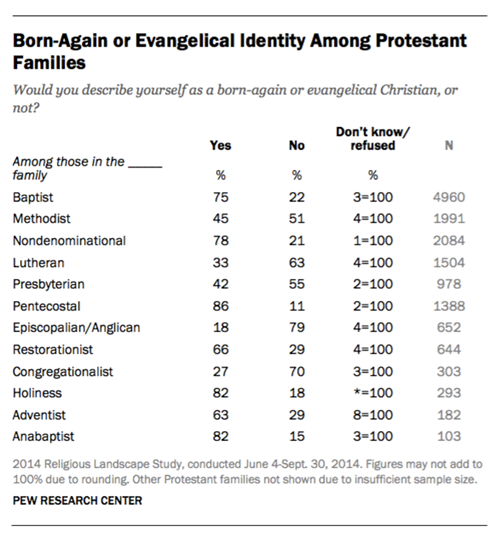
3) Evangelicals convert many and retain their kids
Pew found a "remarkable degree of churn" in the US religious landscape. But evangelicals are the “major exception” to the national pattern of Christian decline, and the only major Christian group in the survey that has gained more members than it has lost through religious switching.
Over the past seven years, evangelicals lost almost 8.5 percent of adherents and gained almost 10 percent for a net gain of 1.5 percent since 2007.
By comparison, Catholics had a net loss of nearly 11 percent due to religious switching, while the unaffiliated had a net gain of more than 13 percent. Mainline denominations had a net loss of more than 4 percent, while historically black denominations had a net loss of less than 1 percent.
Overall, Pew found that "there are more than four former Christians for every convert to Christianity."
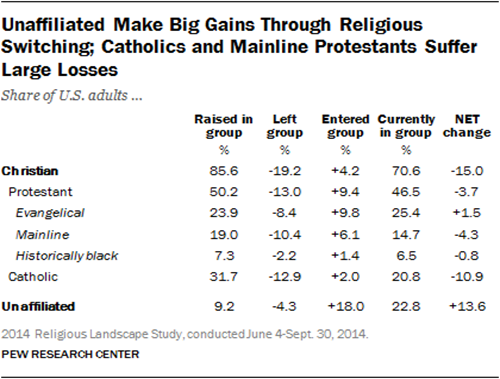
More than 60 percent of current evangelicals were raised as evangelicals, while 14 percent were raised as mainliners, 13 percent as Catholics, 7 percent as unaffiliated, 3 percent as black Protestants, and 2 percent as non-Christian faiths.
Evangelicals retain two-thirds of their children, placing fifth among all religious groups and second among Christian groups. By comparison, Protestants at large retain less than half of their children.
Of the third of those raised as evangelicals who leave the tradition, most switch to no religion at all (15%) or a mainline Protestant church (12%). Only 2 percent become Catholics.
Meanwhile, 19 percent of both Americans raised unaffiliated and raised mainline now identify as evangelicals. So do 10 percent of those raised Catholics and black Protestants, 9 percent of those raised Orthodox, 7 percent of those raised Buddhists, and 6 percent of those raised Mormons.
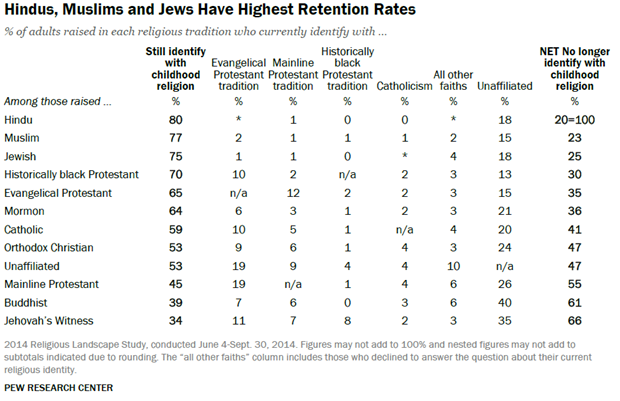
Overall, about half of Americans raised as Protestants remain in their childhood denominational family (47%). About one-quarter now identify with a different Protestant group (27%), while 3 percent became Catholic, 4 percent became non-Christians, and 19 percent became unaffiliated.
Among Protestant denominational families:
- Most likely to retain children as adults: Baptists (57%), Anabaptists (52%), Lutherans (51%), and Adventists (51%). Least likely: Congregationalists (31%), Holiness (32%), Reformed (34%), and Presbyterian (34%).
- Most likely to have children switch within Protestantism: Holiness (45%), Reformed (42%), and Anabaptists (39%).
- Most likely to have children become Catholics: Episcopalians/Anglicans (6%), Lutherans (4%), Methodists (4%), and Reformed (4%).
- Most likely to have children switch to other religions: Episcopalians/Anglicans (8%), Adventists (6%), Presbyterians (6%), and Congregationalists (6%).
- Most likely to become unaffiliated: Congregationalists (28%), Episcopalians/Anglicans (27%), Presbyterians (25%), and nondenominational Protestants (25%).
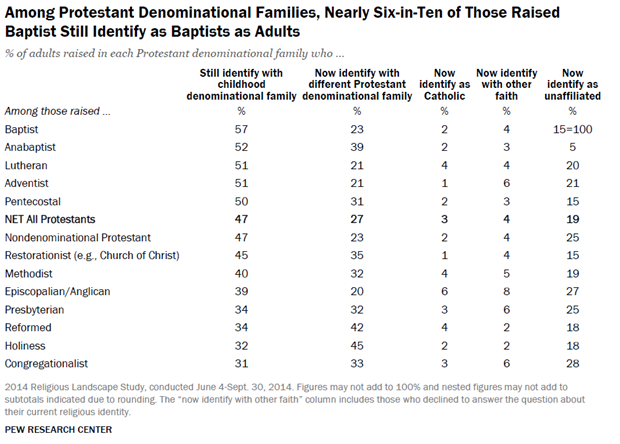
The only group to gain more than evangelicals from religious switching were the unaffiliated, gaining 18 percent (nearly double the evangelical rate) for a ratio of 4.2 people gained for every 1 person lost. Most current "nones" were raised as Catholics (28%), mainliners (21%), or unaffiliated (21%), while 16 percent were raised as evangelicals.
However, the unaffiliated have "one of the lower retention rates among religious traditions," losing nearly half of their children: 9.2% of Americans were raised unaffiliated, while 4.3% of Americans left the group and affiliated with a religion by 2014. Those who found religion were most likely to become Jehovah’s Witnesses (12%), with the rest evenly spread among other religions: Buddhists (8%), Mormons (8%), evangelicals (7%), mainliners (6%), black Protestants (6%), Muslims (6%), Jews (6%), and Orthodox (5%).
Overall, more than 4 out of 10 adults (42%) now have a different religion than they did as children, if switching between mainline, evangelical and historically black Protestant denominations is included. If Protestants are lumped together, then fully one-third of adults (34%) have crossed between religions since childhood, up from 28% in 2007. That means a quarter of all Americans who switched their religion moved within Protestantism.
Pew's study was unable to estimate the number of "reverts," or "people who leave their childhood religion before returning to it later in life."
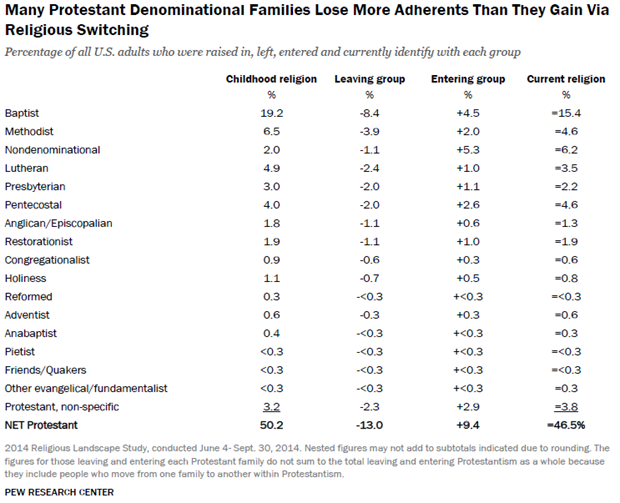
Among today's adults, 20% of mainline Protestants were raised as evangelicals, as were 13 percent of Buddhists, 11 percent of Orthodox Christians, 9 percent of Jehovah's Witnesses, 6 percent of Mormons and black Protestants, 3 percent of Catholics, 2 percent of Jews, and 1 percent of Muslims and Hindus.
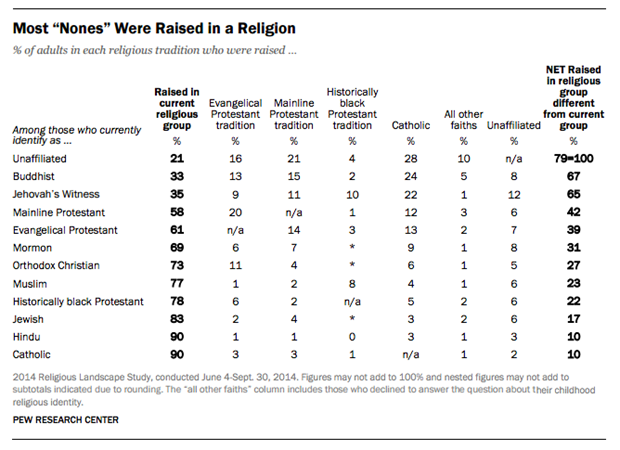
4) Evangelicals are increasingly diverse
Today, more than one-third of US adults who identify as born-again or evangelical Protestants, regardless of denomination, are non-white.
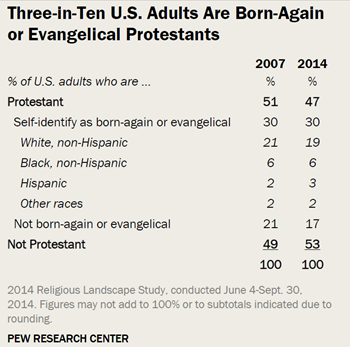
About a quarter (24%) of Americans in evangelical denominations are non-white, up from 19 percent in 2007. (The bump comes primarily from Hispanic evangelicals, up from 7 percent in 2007 to 11 percent in 2014. Black evangelicals have stayed stable at 6 percent, as have Asian evangelicals at 2 percent.)
The increase is nearly the same as other Christian groups. Mainline churches are now 14 percent non-white (up from 9% in 2007), Catholic churches are now 41 percent non-white (up from 35%), and Orthodox Christians are now 19 percent non-white (up from 13%).
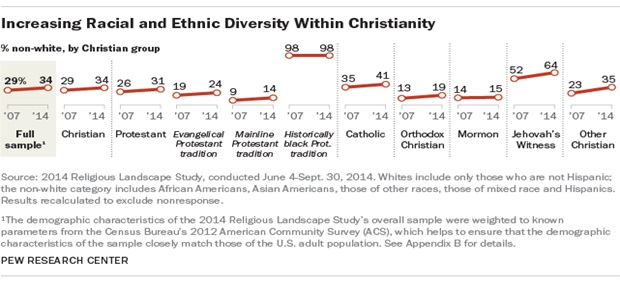
Today, 19 percent of Hispanics identify as evangelicals, as do 14 percent of blacks and 23 percent of other minorities.
Among evangelicals, Asians are the youngest (34% are ages 18 to 29), followed by Latinos and blacks.
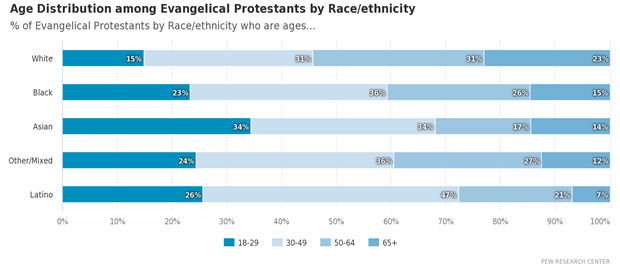
5) Who evangelicals marry and how many kids they have
Three-quarters of evangelicals marry coreligionists, more than historically black Protestants (65%), mainline Protestants (59%), and the unaffiliated (56%). This may account for some of the steady evangelical numbers, as married people tend “to be more religiously active than unmarried people,” Pew reports. “Both groups – those who are married and those who are not – have grown less religiously affiliated in recent years, though married people have done so more slowly.” (The study only examined marriages that were still intact.)
Seven percent of evangelicals have a mainline or unaffiliated spouse, while six percent have a Catholic spouse.
When it comes to kids, 23 percent of evangelicals have never had children, while 42 percent have had two children and 34 percent have had three or more children.
The birth rate for evangelical adults in 2014 was 2.3 children, the same rate as Catholics. Only two groups produce more children: those in the historically black tradition (2.5%) and Mormons (3.4%). The national average was 2.1 percent.
Almost seven in 10 evangelicals had no children at home in 2014, more than the 65 percent who had no children at home in 2007. The rates are nearly identical to the general population: 71 percent had no children at home in 2014, as did 65 percent in 2007.
6) Other findings
- Nearly 4 in 10 Protestants (38%) “offered a vague denominational identity,” including 36 percent of evangelicals, 35 percent of mainliners, and 53 percent of black Protestants. (So Pew classified them by race and whether they identified as born-again or evangelical.)
- Pentecostal denominations such as the Assemblies of God have drawn recent attention for their growth, but Pew finds that it’s actually the nondenominational churches which are growing the most. Nondenominational churches and Pentecostal churches held roughly equal share of the population in 2007, at 9 percent of all Protestants and about 4.5 percent of all adults. But in 2014, 13 percent of Protestants and 6.2 percent of adults identified as nondenominational, while only 10 percent of Protestants and 4.6 percent of adults identified as Pentecostal. (Baptists remain the largest share of Protestants by far, at 33 percent of Protestants and 15.4 percent of all adults.)
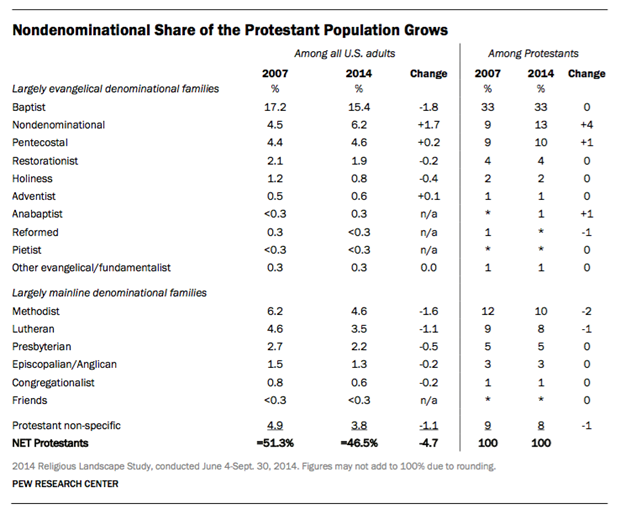
- More gays, lesbians, and bisexuals identify as evangelical (13%) than as atheist (8%) or agnostic (9%). Overall, evangelical ranks as the third most-common identity among this group, after Catholics (17%) and “nothing in particular/religion not important” (14%).
- Two-thirds of US immigrants (68%) are Christians, and 15 percent are evangelicals while 39 percent are Catholics. About 40 percent of Orthodox and Catholic Christians were born outside the US or are the children of immigrants, compared to only 16 percent of evangelicals.
- The share of evangelicals in the West was the only region to rise (from 17% in 2007 to 20% in 2014), while the share of evangelicals dropped 1 percent each in the Northeast (now 9%), Midwest (now 22%), and South (now 49%).
CT covers many Pew reports, including the best prediction yet of how Christianity and Islam will look in 2050, and how scores of Catholics in Latin America are converting to Protestantism.
[Image courtesy of CJF20 - Flickr]

Support Our Work
Subscribe to CT for less than $4.25/month









